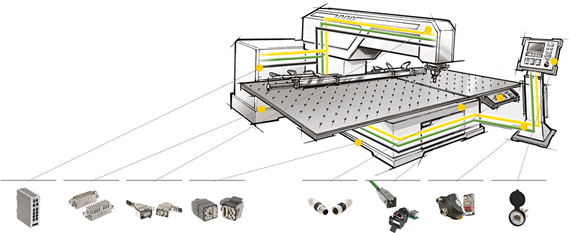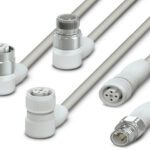Interfaces for Modular Machine Design
Technological developments in today’s industrial environments require modular systems. HARTING’s Jakob Dück examines suitable interfaces for modular machine design.

After cloud computing comes cloud production. This development has significantly impacted machine construction; there is a need for highly flexible, quickly implementable production machines and lines that are fail-safe and can be cost-effectively mass-produced. The goal is to manufacture the equipment in parts that can be shipped to the customer location where they are finally assembled into the completed machine. This is accomplished according to individual customer requirements, with the fewest possible personnel and cost expenditures.
These modular systems, according to a recently published study by Roland Berger entitled “Modular Products,” will have above-average growth in the coming years, especially in the machine-building sector. But it is not possible to implement modular concepts without flexible, versatile connection technology. Mechatronic units are equipped with electrical and mechanical interfaces that are assembled during installation and can be rearranged later if necessary.
This kind of flexibility is not a problem in mechanical interfaces. In contrast, the electrical and electronic power, signal, and data interfaces present a challenge. On the one hand, there is a need for solutions that guarantee unrestricted functionality and compatibility in all possible machine and system configurations. (For example, the interfaces for sensors, drive units, I/O boxes, human-machine interfaces, and complete modules must function no matter where they are positioned.) On the other hand, cost pressures and the resulting need for economical use of resources necessitate scalable interfaces that still meet specific machine configurations. Another key expectation is that the interface be fail-safe and that it can be reliably installed and removed without error, even by non-trained staff.
Supplier Solutions
With regard to connection technology, this means these interfaces must be as variable as possible. Machine-building engineers need to look for a supplier that offers a broad and diversified product portfolio of solutions for all common power, control, signal, and data connections, which will allow them the freedom to concentrate on the central technical aspects of the machine during the design phase. The interface’s less-important technical properties need not be considered (yet).
Some of the important technical properties in the design phase are typical electrical measures such as rated voltage, maximum current-carrying capacity of the contact inserts that are used, and the interface’s space requirements and weight. Developers who choose component suppliers with broad product ranges can be sure there will be no restrictions later when they select the optimal interface for a point of use.
For each of a machine module’s configuration levels, there should be a scalable interface that can grow with the application and which has been optimized in terms of cost and function. In addition, there should be various coding options for the connector housing and inserts, making it possible to configure each interface in such a way that no electrical specialists are needed to install components, connect switch cabinets to the machine, or connect one machine module to another. Such versatile solutions ensure considerable savings in time, resources, and costs, particularly when assembling or testing machine modules or complete machines in the production process at the manufacturer or during the installation of machines and systems at the end customer.
Variability: The Last Word
The benefits of flexibility in interface design can be demonstrated with two examples.
The first example is a high-current interface with up to 40A, which can serve as a power supply for complete machine modules or to control individual larger motors or heating units. For users, only the current-carrying capacity (40 A) of the power contacts is relevant, which can be achieved with a variety of combinations of contact inserts and housings from the right supplier’s portfolio.
The second example includes Ethernet connections in the gigabit range, such as for Ethernet-based bus systems or high-resolution video systems in production. Here again the necessary connections should be available from a broad range of contact inserts and housings from the supplier’s product line.
When building modular machines, engineers should look for a connector supplier that offers a broad range of products that are compatible with many applications while simultaneously increasing the flexibility and variability of the systems in which they are deployed.
[hr]
 Jakob Dück is industry segment manager at HARTING. He can be reached at [email protected].
Jakob Dück is industry segment manager at HARTING. He can be reached at [email protected].





